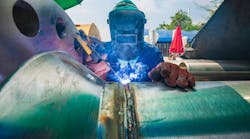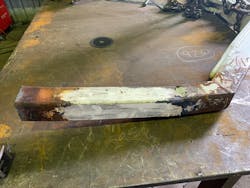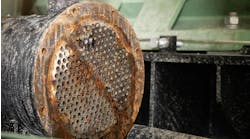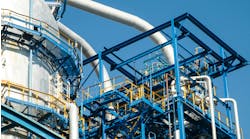Stress Busters: How to Avoid Fatigue-Related Failure in Chemical Processing Equipment
Fatigue-related equipment failures can have devastating impacts on chemical processing operations. For example, equipment and machinery with welded bodies, such as those found on tanks, pressure vessels and bulk material handling systems, can crack, buckle or collapse, causing leaks, fires and safety incidents.
Chemical plant operators must understand how operational and environmental loads lead to potential causes of failure. Many operational loads, such as dynamic machinery, repeated/cyclic (for instance, loads due to batch operation), thermal and random loads can cause fatigue and related failures.
A closer look at failure prevention in chemical processing equipment can help plants increase uptime and reduce potential safety hazards. The aim of these practical notes and guidelines is to help process plant operators grasp fundamental prevention strategies, focusing on clarity rather than presenting complex mathematical formulations or tables.
Uniform Stress and Stress Concentration
A component, part or item is stronger when the force or load is evenly distributed over its area. Any discontinuity or sharp change results in a localized stress increase. This is known as stress concentration, stress raiser or stress riser. Parts, components and members usually have holes, grooves, notches, keyways, shoulders, threads or other abrupt changes in geometry that create a disruption in the otherwise uniform stress pattern.
These irregularities and anomalies result in stress concentration zones for nearly any part of machinery, equipment or facility in chemical processing plants. It’s often difficult to design parts and pieces of a machinery or equipment without some changes in the cross section or geometry. Rotating shafts should have shoulders, so the bearings can be properly seated, and they will take thrust loads. The shafts/rotors should usually have key slots machined into them for securing rotating components. Other parts require holes, oil grooves and notches of various kinds.
In a more general context, stress concentration refers to its accumulation within a body caused by a sudden change in its shape, loads, or material properties. The body tends to fail from these places of stress concentration. To prevent such failures, it’s important to avoid or reduce stress concentrations.
Many loads and moments (such as support loads, piping nozzle loads, lifting loads, etc.) have usually been applied in limited geometries and areas. This also can cause stress concentration, large stresses in the vicinity of the load application.
Stress Concentration vs. Ideal Ductile Behavior
Stress concentration is often neglected when material behaves as a ductile material under an ideal, static loading situation. This might be the case for ductile steels in ambient, normal or relatively high temperatures. However, the situation is different in many practical cases, such as processes involving low temperatures, special geometries, those under cyclic/repeated/dynamic/impact loads and others. In other words, truly ductile materials may not be as susceptible to stress concentration and associated rapid failures since they can yield plastically or deform at the points of localized stress and not exhibit immediate failure. However, such a pure and ideal ductile behavior can be deviated due to many reasons, for instance, at low temperatures. Another concern is cyclic/repeated loads, which could result in crack development in these stress-concentration points.
Fatigue
Fatigue results when damages accumulate from a repeating load or loads that are variable in magnitude, direction, or both. Any loads that change the direction of action in operation or change its value can cause fatigue. Resulting damages normally occur under purely elastic stresses. However, due to stress concentrations, plastic stresses are possible in very small areas of the equipment or components. Once enough damage has accumulated, fatigue fracture will initiate and propagate. Fatigue calculations are quite complex. Codes and standards have offered some simplified models to describe fatigue behavior. But the accuracy is usually limited.
Cracks
Cracks can develop in components and members during fabrication processes, such as welding, cold working or grinding. Operators should perform a systematic check-up to evaluate the damage caused by cracks, so proper prevention methods can be adapted. They also can use non-destructive tests (NDTs) to detect cracks. It is also important to systematically check for possible stress concentrations caused by cracks.
In many practical engineering situations, a failure occurs when cracks spread in the presence of large stress concentrations. The stress in the presence of such irregularities typically appears in a three dimensional in form, thus increasing the difficulty to evaluate the situation. In particular, stress concentrations coupled with cyclic or repeated loading (fatigue loading) cause a large number of failures. The same principle applies to components and parts subjected to dynamic loads, shocks, or impacts, like bulk material handling systems, chutes and hoppers affected by the impact of discharged solids.
There exists a crucial crack length that, once surpassed, leads to an inevitable catastrophic failure caused by the crack. This ultimate failure is definite since the crack will propagate on its own once the length is greater than the critical crack length. In other words, there is no additional energy required to increase the crack length, so the crack will continue to enlarge until the material fails.
The maximum stress felt near a crack occurs in the area of lowest radius of curvature (sharp edges). As the radius of curvature approaches zero, the maximum stress approaches infinity. The stress concentration factor is more a function of the geometry of a crack, rather than its size.
Endurance Limits and Fatigue Strength
Endurance limits are the fatigue strength of infinite/unlimited life under cyclic/repeated loads. A good way to reach theoretical infinite fatigue life is to design machineries and equipment under cyclic loads (or fatigue) based on endurance limits. However, there are some challenges. These endurance limits are relatively low compared to the ultimate strength of materials. For instance, as rough indications, for many steels, alloys and metals, the endurance limit is less than one-fifth or one-sixth of the actual tensile strength. In many practical cases, the equipment, parts or components are under other adverse effects such as corrosion, erosion, environmental effects, and other punishing factors. This can affect the overall fatigue life and failure mode. Typically, corrosion fatigue endurance limits are even far lower. This means parts and components would fail under relatively low cyclic/repeated stresses.
High-Strength Steels and Complications
Many applications comprise high-strength steels to create cost-effective, compact and lightweight equipment and facilities. The introduction and use of high-strength steels and more complex shapes and configurations can affect the fatigue process and fatigue life (life of the equipment in operation under fatigue). The use of high-strength steels in process equipment and pressure parts normally mean higher stress levels and, hence, an increased sensitivity to defects, deviations in weld geometries (for instance, penetration, throat thickness, undercuts, etc.) and variations in material strength. To increase fatigue life, chemical process operations should consider better welding, improved surface treatment technologies and better manufacturing techniques when using high-strength steels . In other words, the risk of fatigue is relatively high for equipment fabricated from high-strength steels, particularly if welding and manufacturing are not of high quality.
Fatigue in Welded Equipment
The body, casing or frame of processing equipment and components are often complex welded assemblies. The failure of welded bodies and assemblies due to fatigue is a major concern. Too often this failure is due to crack growth at or around welding areas.
Unfortunately, it is common to see cracks in equipment and machineries after some time of operation and in many cases, cracks are at or around welds. NDT (non-destructive test) on equipment, machineries, piping and others, after years of operation, would reveal several cracks developed on their key weld areas due to fatigue. Weld geometries and defects strongly influence the fatigue life of the welds and welded bodies.
The development and manufacturing of welded bodies (equipment, piping, etc) under cyclic/repeated loads need great expertise, skills and know-how. Practically fatigue and its associate failures and problems are great risks and challenges to these equipment and facilities.
Weld Quality vs. Fatigue Strength
The local weld geometries affect the stress concentration factor of the weld. The welding process usually creates crack-like defects, which together with other effects cause a large scatter in fatigue life depending on differences in these factors. There are links between the weld quality and the fatigue (fatigue life, crack growth, possible failure, etc). In other words, the overall weld details including welding design, details of welding joints, welding process, heat input, quality of each welding pass and others would affect the fatigue strength of the weld and the welded body.
This picture is more complicated when using a high-strength steel and for complex welded bodies or equipment, where fatigue-driven cracks are commonly reported. All these considerations are important elements in the manufacturing and functioning of welded assemblies, requiring meticulous attention across all phases, including design, construction, inspection and operation of equipment and facilities.
High-quality materials can help mitigate fatigue and prevent failures. But it’s not always cost-effective. Exotic materials might be difficult to implement or excessively expensive. Instead, operators should focus on improving the load-bearing capability of complex welded equipment and bodies through better fatigue evaluation methods and high-quality welding. The fatigue strength and fatigue life are closely related to weld joint details, welding processes and weld quality.
Global and Local Buckling
Buckling-related failures, which can manifest as buckling under compression and bending, lateral buckling, lateral-torsional (spatial) buckling, complex buckling modes (considering the axial thrust, bending and lateral) and overall lateral instability is another common source of process equipment breakdowns.
Buckling is a major consideration for members and assemblies under compression or combined compression and bending. Parts and members of intermediate slenderness usually fail by elastic-plastic buckling (or inelastic buckling). In this type of buckling, both yield and buckling occur together. In practice, most members and components fall in intermediate slenderness ratio as slender members have nearly always been avoided.
For shells and thin-wall parts, the thickness plays a major role in the mechanical behaviour and risks of buckling. Insufficient thickness would result in local yielding and local buckling. For this reason, it’s critical that process operators pay close attention to equipment, bodies and piping from thin plates, thin shells and thin-wall sections, particularly those around or below 4 mm thickness.
Practical Guides and Useful Recommendations
Local weld shapes and various defect types and imperfections strongly influence the fatigue strength. Addressing these factors starts with recognizing the potential risks and hazards linked to failures, such as fatigue-related crack development. Fatigue, especially, poses a significant risk, requiring careful consideration whenever there's a chance of cyclic or repeated loading on the equipment or facility. The subsequent stage involves acknowledging the uncertainties and lack of precise determinations regarding fatigue-related parameters and properties, as well as cyclic or repeated loads. This necessitates the utilization of suitable safety margins and employing somewhat conservative design and evaluation approaches.
Typically, making slight adjustments to the part or component shape can significantly reduce stress concentration. For instance, it is advisable to avoid sharp corners. Using a sufficiently large radius in the geometry change helps minimize stress concentration.
To decrease stress concentration, operators can avoid sharp corners by incorporating a fillet radius at those points or using a chamfer. These alterations help distribute stress more evenly throughout the body. Also, these measures can mitigate the risks associated with crack development and fatigue failures.
Other key recommendations are:
- In the design stage, it’s advisable to reduce the allowable stresses to sufficiently low levels, acknowledging risks of fatigue failure and other problems.
- During detail design, materials procurement, the welding process and fabrication, operators should enforce high standards aimed at avoiding or eliminating adverse effects, such as sharp edges, material defects, sharp notches, poor welding or corrosion.
- It’s important to inspect for potential failure points during the installation, commissioning, operation and maintenance of any piping vulnerable to cyclic or repeated loads and fatigue. This includes the use of condition monitoring, NDT and inspections. For example, conducting additional inspections is necessary to detect the formation of cracks.
For chemical process operators, it's vital to comprehend the significant impact of stress concentrations, crack development, fatigue and buckling on equipment. To mitigate these risks, operators should consider design adjustments and focus on minimizing stress build-up. Prioritizing stringent standards throughout design, fabrication, inspection, and maintenance is key, along with proactive methods to prevent potential failure points and maintain safety.




